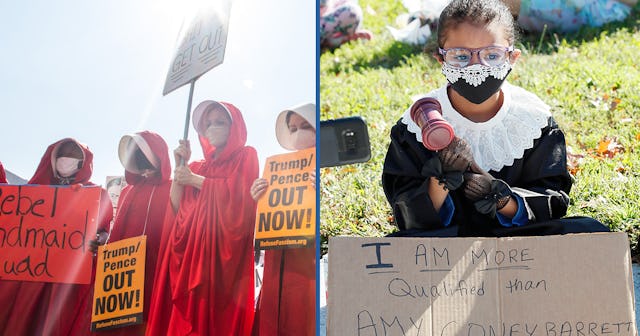Women's March 2020 Drew Thousands Of Protesters Across The U.S.

Thousands gathered to honor RBG, protest the Supreme Court nomination of Amy Coney Barrett, and urge people to vote
On Saturday, women from across the country participated in more than 430 marches as part of this year’s Women’s March. Protesters of all ages not only paid tribute to the late Justice Ruth Bader Ginsburg, but they also protested the Supreme Court nomination of Judge Amy Coney Barrett and urged people to vote President Donald Trump out.
The Women’s March took place just days prior to the Senate’s first vote confirming Barrett as Ginsburg’s replacement. The Senate Judiciary Committee is scheduled to vote Thursday on the nomination of Barrett.
Paul Morigi/Getty Images
“From Denver to Durham to D.C., women sent an unmistakable message: We’ve had enough,” Women’s March tweeted yesterday. “We reject Trump’s agenda that doesn’t include all of us, and we will unite across our differences to vote him out.”
In D.C. for the second Women’s March of the year (the fourth annual Women’s March took place earlier this year), women dressed in red robes and white bonnets à la The Handsmaid’s Tale chanted, “In the name of humanity, we refuse to accept a fascist America.”
Signs that read “Trump/Pence OUT NOW!” — along with the website RefuseFascism.org — hung from their necks.
Women and children alike also wore black robes costumes and white-lace collars honoring RBG and holding signs, like “Ruth Sent Me” and “We must now be RUTHLESS.”
“You can use social media all you want, but there’s something to be said about showing up,” Justina Gilliam tells The Washington Post. Gilliam’s 7-year-old daughter, Harriet, dressed as RBG and 7-year-old son, Myles, dressed as late civil rights leader John Lewis. And according to D.C. reporter Kolbie Satterfield, the family traveled from Boston to attend both the Women’s March and the Supreme Court protest. “Their mother says this is her daughter’s third Women’s March and her son’s second,” Satterfield tweeted.
For women who’ve attended past Women’s Marches, they’ve noted a different tone at this year’s march.
“Every weekend, the signs are getting a little more hostile and darker,” Ginger Belmonte also tells The Washington Post. Belmonte is a protester who’s traveled to D.C. every weekend since Ginsburg died. “This year’s march feels even more urgent than the first one, after President Trump’s inauguration. We didn’t know the severity of how bad it was going to be. It’s actually happening.”
However, while the tension was palpable, so were feelings of unity, strength, and power.
“Today, we showed the nation what the power of everyday women looks like,” the Women’s March wrote. “From AK to MN, to D.C. —when we come together, march, and turn out to vote, women are the strongest political force in America. And there’s nothing Trump can do about it.”
“We want our lives back from this administration,” Women’s March continues. “And we want a whole different future: a story we are all written into. We aren’t scared—we’re mobilized, we’re organized, and most of all, we’re motivated. We have the power. Women have the power to end this presidency.”
For more information about the Women’s March organization and ways to take action, visit WomensMarch.com.